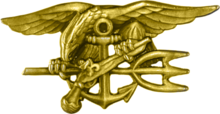Special Warfare Insignia
The Special Warfare Insignia , officially also SEAL Trident , but mostly just called The Budweiser (Eng. "The Budweiser") within the US Navy , is the qualification and job badge of the US Navy SEALs . The SEAL Trident is considered one of the rarest and most sought-after qualification badges in the US armed forces .
There are currently around 2,000 active sponsors.
history
It was first issued in the 1970s during the Vietnam War , in order to also externally separate the special unit , which was set up in 1962, from the underwater demolition teams from which it emerged.
description
The Special Warfare Insignia (German: "Badge for special warfare") consists of a golden eagle with a naval anchor, trident and a pistol in its claws . The ensemble is regarded as a successor badge , based on the weapon divers' underwater demolition badge . The badge is intended to symbolize the triphibian usability and the resulting name of the SEALs, sea, air and land. The anchor indicates membership of the Navy, the eagle indicates the ability to jump , the harpoon or the trident indicate the ability to dive into combat and weapons , and the pistol indicates the ability to command on land.
Award prerequisites
In order to receive the Special Warfare Insignia , the candidate must have successfully completed the Navy SEAL training , the Basic Underwater Demolitions / SEAL training (BUD / S) and the SEAL Qualification Training (German “SEAL Qualification course "). Only then is he a fully-fledged combat swimmer and commando soldier, is assigned to a Navy SEAL team or Special Delivery Vehicle (SDV) team and is entitled to wear the badge.
stages
Originally the badge had two levels, one in gold for officers and one in silver for all non-commissioned officers and men. In the 1970s the silver badge was abolished and the gold one was introduced as the Special Warfare Badge . This justifies its unique position within the Navy, as there is always a dichotomy in qualification badges. Regardless of their rank, this is intended to document the bond between the SEALs and to show that officers and crews can only successfully go through the extremely selective SEAL qualification course together.
Use of the badge
An authorized soldier receives the badge and is included in the US Navy Ratings (Warfare Qualification) and is entitled to use the SEAL job title according to his rating designator (German: "Usage designations"). In 2006 all SEAL emergency services were reclassified as Special Operators (SO) , which means, for example, that the job title is now SO2 instead of MM2. Since there are over twenty different qualifications within the SEAL application group, but these have not been changed, the old numbers are simply followed by the prefix SO.
The community of active and former SEALs is facing a growing and inflationary trade and use of badges by unauthorized persons, which, to their regret, is not illegal when worn in combination with civilian clothes. Some veterans' organizations deal with the prosecution, documentation and public denunciation of unauthorized carriers.
Nickname
Since the Special Warfare Insignia is only given to successful graduates of Basic Underwater Demolitions / SEAL training (BUD / S), but the abbreviation BUD / S sounds just like the popular short name of a Budweiser beer, the ironic nickname The Bud (dt. The Budweiser (badge) ”).
literature
- Hartmut Schauer: US Navy SEALs , Motorbuchverlag Stuttgart 2000. ISBN 3-613-01864-0 , p. 141
Web links
- Uniforms and badges at npc.navy.mil (English)
Individual evidence
- ↑ Hartmut Schauer: US Navy SEALs , Motorbuchverlag Stuttgart 2000. ISBN 3-613-01864-0 , p. 141
- ↑ Special Warfare Operator (SO) Rating and SEAL Warfare Designator at navyseals.com ( Memento from February 17, 2012 on WebCite )
- ↑ VeriSEAL The original SEAL Verification Project . Retrieved February 15, 2011.


